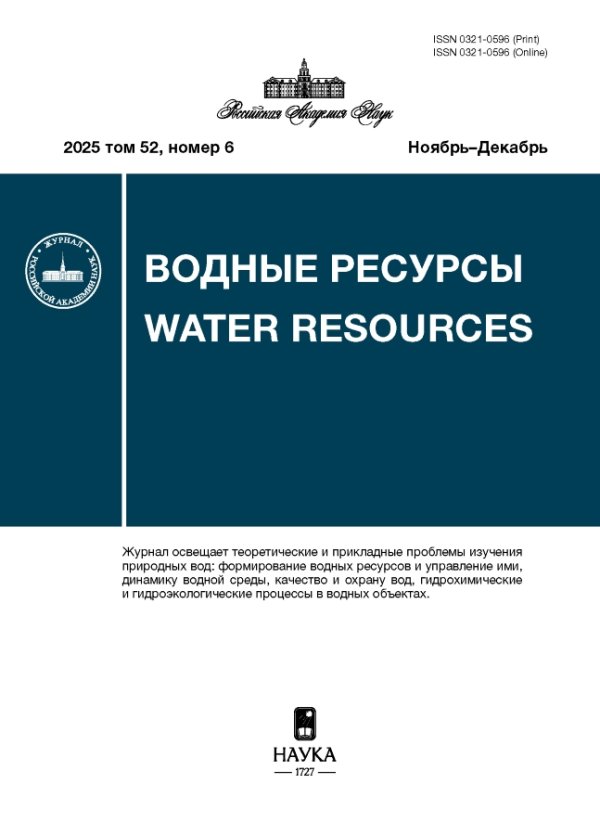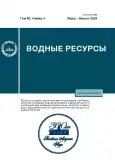Vol 50, No 4 (2023)
МАТЕМАТИЧЕСКИЕ МОДЕЛИ В РЕШЕНИИ ЗАДАЧ ГИДРОЛОГИИ СУШИ
Experience in Numerical Hydrodynamic Simulation of Long River Reaches
Abstract
The article formulates the main requirements to numerical algorithms for hydrodynamic 2D-modeling of long and very long river segments with lengths of up to several thousand kilometers. The main feature is the use of adaptive unstructured mesh along with algorithms that give correct values of water surface elevations on coarse mesh, taking into account abrupt changes of bed elevations. A hydrodynamic model of a segment of the Amur R. with a total length of >3 thous. km is presented, which is based on a numerical solution of two-dimensional shallow-water equations (Saint-Venant) by a new high-accuracy algorithm, taking into account road and protection structures in the floodplain. The stages of model construction and verification are described, and the results of calculations for an extraordinary flood in 2013 and a high flood in 2020 are given. Water levels (with estimates of their errors) and the rates of water discharge at gages are given along with flow fields and the inundation zones of floodplain areas.
 367-384
367-384


Numerical 2D-Modeling of Rain Runoff Transformation in the Drainage Basin of Gelendzhik City Taking into Account the Mountain Collector and Accumulating Reservoirs
Abstract
A digital relief model of a mountain cluster and location schemes of mountain collectors and reservoir dams were used to develop a numerical hydrodynamic 2D-model of the mountain part of the drainage basin of Gelendzhik City area and to perform variant calculations of rain flood waves, taking into account their transformations in mountain collectors and accumulation in reservoirs. The rains considered in the model were assumed to have the exceedance probability of 1% and the duration of 20 and 720 min (12 h) with a total rainfall depths of 51 and 206 mm, respectively. Conclusions were made that the carrying capacity of the collector should be calculated for the parameters of a short-time intense rain and that the accumulating hydraulic structures, for their efficient operation, should be designed to allow continuous regulation of discharge rates.
 385-394
385-394


A FCM Runoff Model for Small Rivers with Rainfall Recharge. 1. The Concept and Algorithms
Abstract
The flood cycle model FCM is a lumped conceptual water-balance model designed to simulate rain runoff at a scale of a small river basin. The development of the FCM model includes the description of the dynamics of the major components of the total moisture reserves of a basin and reproduces the effect of spatial expansion of the drainage network through temporary surface and subsurface streams during extraordinary floods. The accepted conceptual assumptions of the model, which are in agreement with the rational hydrological considerations, lead to three runoff-formation regimes, referred to as intravolume, surface and breakthrough. The concept and algorithms of FCM are given in detail.
 395-406
395-406


A FCM Runoff Model for Small Rivers with Rainfall Recharge. 2. Parameterization and Verification
Abstract
The specific features of the parameterization and verification of FCM model were analyzed, and the data published before, as well as new results of the authors’ field observations, are systematized. The parameterization algorithms and the results of model testing in different regions with the predominance of rain floods in river regime are described. The basis and empirical confirmation of some principal hypotheses of FCM are discussed and the so-called effect of basin buffer storage is considered. This most vivid manifestation of the nonlinearity of the extreme runoff formation is, though a rare, but principally important phenomenon in the formation of extraordinary rain floods.
 407-422
407-422


Simulating the Dynamics of the Characteristics of Snow Cover Formation Regime in the Russian Federation Territory. 1. Field Areas of ER in the Historical Period
Abstract
A procedure for calculating various characteristics of snow cover formation, based on the use of the land surface model SWAP, was tested on field areas of the European Russia for a historical period (1967−2019). The comparison of simulation results with observation data showed the good quality of snow water equivalent reproduction at these objects. Variations of the climatic values of snow cover formation characteristics in the historical period were analyzed, revealing trends in changes of these characteristic in field areas in the period under consideration.
 423-437
423-437


Simulating the Dynamics of the Characteristics of Snow Cover Formation Regime in the Russian Federation Territory. 2. Forest Areas of ER in the Historical Period
Abstract
A procedure for calculating various characteristics of snow cover formation, based on the use of the land surface model SWAP was tested on forest areas of the European Russia for a historical period (1967−2019). The comparison of simulation results with appropriate observation data showed the good quality of reproduction of snow formation processes at these objects. Changes of the climatic values of snow cover formation characteristics in the historical period were analyzed to reveal tendencies in these changes in forest areas in the region. Thus, it was found that, despite the decrease in the duration of snow cover, there is increase in snowpack, in particular, in the maximal snow water equivalent. The difference between the characteristics of snow cover formation in the field and forest areas of European Russia was assessed. The mean values of the snow accumulation coefficient over the forest area relative to the field was found to be greater than 1.0. At the same time, the climatic changes in the historical period lead to a decrease of this characteristic in time.
 438-450
438-450


River Runoff in European Russia under Global Warming by 1.5 and 2 Degrees
Abstract
The ECOMAG hydrological model was used to evaluate runoff characteristics in the basins of the major rivers in European Russia: the Volga, Don, Northern Dvina, Pechora, and Kuban. The models of runoff formation for various hydrometric gauging stations in these basins were calibrated using data of weather station observations. Next, the input data were represented by the data of an ensemble of global climate models for assessing the regional hydrometeorological regime at the realization of a scenario of global warming by 1.5 and 2°C in the XXI century relative to the preindustrial values. The reproduction of the annual and seasonal runoff by data of climatic models was evaluated by comparison with observation data. According to the results of numerical experiments at global warming by 1.5 and 2°C, the values of the relative changes in river runoff in European Russia increase from N to S and from E to W, i.e., the hydrological systems under milder climate were found to be more sensitive to changes in the meteorological characteristics. The estimation of runoff anomalies in the European Russia showed the following common features: an increase in the winter runoff in the northern rivers and in the Volga basin, a decrease in the spring snowmelt runoff in the Northern Dvina, Volga, and Don, a decrease in the summer–autumn runoff of all studied rivers with various intensity. In this case, the annual runoff of the Pechora will show a positive trend, and that of the Northern Dvina, Volga, Don, and Kuban, a negative trend.
 451-464
451-464


The Effect of Natural and Anthropogenic Climate Changes on River Runoff and Snow Water Equivalent in the Lena River Basin
Abstract
The hydrological models ECOMAG and HBV were used to calculate the characteristics of river flow and snow Water Equivalent in the Lena River basin. The input data included the meteorological observations and the results of calculations with global climate models with the implementation of scenarios of natural climate conditions, taking into account the anthropogenic effect on climate. The calculations were made for a historical period (1970–1999) and up to the end of the XXI century. Hydrological models for several hydrometric gages in the Lena basin were calibrated and verified. The simulation of the annual and seasonal runoff using the climate model data was evaluated by comparison with observation data. According to the results using numerical experiments over the historical period, the increase in the Lena runoff is mostly due to natural climate variations. Conversely, in the XXI century, the anthropogenic climate changes determine the specific features of the regime of river runoff and snow cover. The warming caused by an increase in greenhouse gas concentrations in the atmosphere leads to an increase in snow water equivalent and transformation of the hydrological regime in the area, in particular, to an earlier beginning of active snow melting (up to two weeks) and higher maximal discharges during spring flood. At the same time, the volume of runoff decreases in the summer and increases in the autumn and winter.
 465-476
465-476


Evaluating Inundation Characteristics under Climate Changes
Abstract
A procedure of hydrodynamic modeling of floodplain inundation characteristics is presented; the procedure takes into account climate change scenarios and is based on the results of numerical experiments with river runoff formation model and the results of ensemble calculations by global climate models. The model calculations were based on Russian software systems ECOMAG and STREAM_2D. For the key segment of the Lena at Yakutsk C. (Tabaga gage), the calculations by all scenarios and models show a possible increase in the runoff by the mid-XXI century along with an increase in the inundation areas and depths by 9–15% due to the increase in runoff.
 485-491
485-491


Modeling the Genetic Components of the Water and Chemical Runoff of Heavy Metals in the Basin of the Nizhnekamskoe Reservoir
Abstract
A semi-distributed physical-mathematical model ECOMAG-HM is used to simulate the genetic structure of water and chemical runoff of copper, zinc, and manganese in a large river basin of the Nizhnekamsk Reservoir. The model was tested against long-term data of hydrological and hydrochemical monitoring of water bodies. The contributions of the surface, soil, and subsoil components of the water and chemical runoff of metals are estimated for different segments of river network. It was found that, in the major portion of the catchment, river pollution by metals is mostly due to their diffuse washout from the soil layer. The effect of the genetic structure of water and chemical runoff on the year-to-year and seasonal variations of metal concentrations in the river network is demonstrated.
 492-508
492-508


Simulating Runoff Regime in a Glaciated High-Mountainous Basin: A Case Study of the Baksan River (Caucasus, Russia)
Abstract
The water resources of the North Caucasus depend mostly on the state of glaciers, which have been intensely losing their mass in the recent decades against the background of climate changes. The deglaciation leads not only to a decrease in the glacier runoff of mountain rivers, but also to changes in the annual distribution of runoff. The focus of this study is the adaptation of ECOMAG software complex to simulating river runoff in the Baksan River basin based on data on the relief and underlying surface of the drainage basin (soil, vegetation) and daily data on the surface air temperature, air saturation deficit, and precipitation. The calibration and validation of the model and the statistical estimate of calculation efficiency were based on the data on water discharges in the Baksan River over 2000–2017. The developed model of runoff formation in the Baksan River basin was used to carry out numerical experiments for assessing the sensitivity of runoff characteristics to glacier area variations. Depending on the rate of deglaciation process, the runoff of the Baksan River can drop by 10–30% because of a decrease in its glacial component, and the maximal water discharges can drop by 10–15%.
 477-484
477-484












